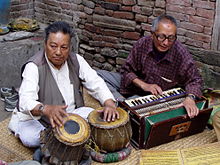
Religious music is a type of music that is performed or composed for religious use or through religious influence. It may overlap with ritual music, which is music, sacred or not, performed or composed for or as ritual. Religious songs have been described as a source of strength, as well as a means of easing pain, improving one's mood, and assisting in the discovery of meaning in one's suffering. While style and genre vary broadly across traditions, religious groups still share a variety of musical practices and techniques.

In music, the organ is a keyboard instrument of one or more pipe divisions or other means for producing tones. The organs have usually two or three, up to five manuals, for playing with the hands, and pedalboard, with the feet. With the use of registers, several groups of pipes can be connected to one manual.

Bhajan refers to any devotional song with a religious theme or spiritual ideas, specifically among Indian religions, in any language. The term bhajanam means reverence and originates from the root word bhaj, which means to revere, as in 'Bhaja Govindam' . The term bhajana also means sharing.

The dholak is a two-headed hand drum, a folk percussion instrument. The dholak is most commonly recognised in countries such as India, Pakistan, Bangladesh, Nepal and Sri Lanka, but can also be found amongst the Indo-Diaspora in countries such as Guyana, Suriname, Fiji, Trinidad and Tobago, South Africa and Mauritius. The dholak can be anywhere about 16" to 24" in length. It is widely used in qawwali, kirtan, bhajan, bhangra, chutney, baithak gana, Bollywood film songs, lokgeet and various classical styles such as Hindustani, Carnatic and Trinidadian local classical / Guyanese taan. The drum has two different sized drumheads. There is a smaller drumhead that can be from 5.5 to 8 inches in diameter and is made for sharp notes while the bigger drumhead, which can be from 7.5 to 10 inches in diametre, is made for low pitch. The two drumheads allow a combination of bass and treble with rhythmic high and low pitches. The body or shell of the Dholak can made of sheesham or mango wood. The larger drum head has a compound of tar, clay and sand, called "masala" which is applied to lower the pitch and produce the sound. The smaller drumhead is played with the person's dominant hand, while the larger is played by the person's weaker hand. A dholak can either be fitted with a nuts and bolts or a rope and steel rings for tuning. Commonly in the Indian subcontinent, there are only one set of rings for tuning the treble side of the dholak, while in the Caribbean, hook screws are placed into the sides of the dholak to allow tuning of both the treble and the bass. Dholak can be played in three ways — on the player’s lap, while standing, or pressed down with one knee while sitting on the floor.

Qawwali is a form of Sufi Islamic devotional singing originating in South Asia. Originally performed at Sufi shrines or dargahs throughout South Asia, it is famous throughout Pakistan, India, Bangladesh and Afghanistan and has also gained mainstream popularity and an international audience as of the late 20th century.
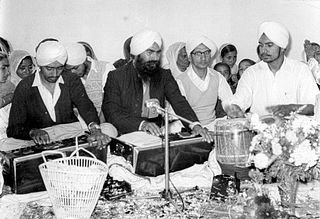
Kirtana, also rendered as Kirtan or Keertan, is a Sanskrit word that means "narrating, reciting, telling, describing" of an idea or story, specifically in Indian religions. It also refers to a genre of religious performance arts, connoting a musical form of narration or shared recitation, particularly of spiritual or religious ideas, native to the Indian subcontinent. A person performing kirtan is known as a kirtankara.

A shruti box is an instrument, originating from the Indian subcontinent, that traditionally works on a system of bellows. It is similar to a harmonium and is used to provide a drone in a practice session or concert of Indian classical music. It is used as an accompaniment to other instruments and notably the flute. The shruti box is also used in classical singing. In classical singing, the shruti box is used to help tune the voice. The use of the shruti box has widened with the cross-cultural influences of world music and new-age music to provide a drone for many other instruments as well as vocalists and mantra singing.

The khol is a terracotta two-sided drum used in northern and eastern India for accompaniment with devotional music (bhakti). It is also known as a mridanga, not to be confused with mridangam. It originates from the Indian states of West Bengal, Assam and Manipur. The drum is played with palms and fingers of both hands.
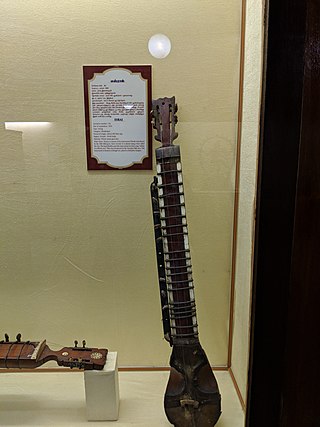
The esraj or esraaj is an Indian stringed instrument found in two forms throughout the Indian subcontinent. It is a relatively recent instrument, being only about 300 years old. It is found in North India and Pakistan, primarily Punjab, where it is used in Sikh music and Hindustani classical compositions and in West Bengal. The esraj is a modern variant of the dilruba, differing slightly in structure.

The pump organ or reed organ is a type of free-reed organ that generates sound as air flows past a vibrating piece of thin metal in a frame. The piece of metal is called a reed. Specific types of pump organ include the American reed organ, the Indian harmonium, the physharmonica, and the seraphine. The idea for the free reed was derived from the Chinese sheng through Russia after 1750, and the first Western free-reed instrument was made in 1780 in Denmark.

An expression pedal is an important control found on many musical instruments including organs, electronic keyboards, and pedal steel guitar. The musician uses the pedal to control different aspects of the sound, commonly volume. Separate expression pedals can often be added to a guitar amplifier or effects unit and used to control many different aspects of the tone.

The Seni rebab, also known as the Seniya rabab is a plucked string instrument used in northern India that is said to have been developed by, and to have taken its name from, the notable musician Tansen in the time of the emperor Akbar the Great. It has "a large hook at the back of its head, making it easier for a musician to sling it over the shoulder and play it even while walking." It has been used in Hindustani classical music and religiously, in Sikh music. The rebab influenced the development of the sarod, another Indian musical instrument.

Kafi is a classical form of Sufi music mostly in the Siraiki, Punjabi and Sindhi languages and originating from the Punjab, and Sindh regions in the Indian subcontinent. Some well-known Kafi poets are Baba Farid, Bulleh Shah, Shah Hussain, Shah Abdul Latif Bhittai, Sachal Sarmast and Khwaja Ghulam Farid. This poetry style has also lent itself to the Kafi genre of singing, popular throughout South Asia, especially Pakistan, Bangladesh and India. Over the years, both Kafi poetry and its rendition have experienced rapid growth phases as various poets and vocalists added their own influences to the form, creating a rich and varied poetic form, yet through it all it remained centered on the dialogue between the Soul and the Creator, symbolized by the murid (disciple) and his Murshid (Master), and often by lover and his Beloved.
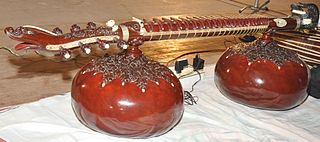
The Rudra veena —also called Bīn in North India—is a large plucked string instrument used in Hindustani Music, especially dhrupad. It is one of the major types of veena played in Indian classical music, notable for its deep bass resonance.

Sikh music, also known as Gurbani Sangeet , and as Gurmat Sangeet, or even as Shabad Kirtan, is the classical music style that is practised within Sikhism. It exists in institutional, popular, and folk traditions, forms, and varieties. Three types of Sikh musicians are rababis, ragis, and dhadhis. Sikh music exists in various melodic modes, musical forms, styles, musicians, and performance contexts.

The taus, originally known as the mayuri veena, is a bowed string instrument from North India. It is a form of veena used in North India with a peacock-shaped resonator called a mayuri, and is played with the neck of the instrument on bow.

German Jubilate Harmonium Reeds are brass reeds used in Indian harmoniums that were manufactured in Germany between 1911 and the early 1960s. The reeds were originally manufactured for American style suction reed organs being manufactured in Germany on machinery that was bought second hand in Chicago in the United States and imported to Germany by Karl Mannborg son of Theodor Mannborg. Mannborg owned the factory in Pegau, Germany supplying organ parts for American style suction reed organs. Germany was the only country in Europe that was manufacturing American style suction reed organs while the rest of the reed organ industry in Europe was making pressure reed Harmoniums.

Rababi is a term used to refer to a player of the rabab instrument.
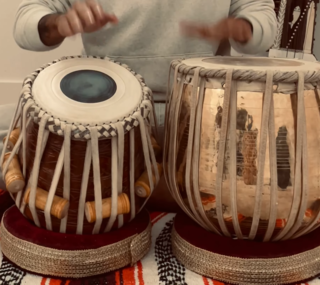
Jori, Jodi, Dhamma, or Jorhi is a South Asian percussion instrument made up of two individual drums. The Jori originates from the Punjab region of South Asia. Historically, the Jori has accompanied Gurbani Kirtan. Prominent exponents of the Jori include Ustad Sukhvinder Singh 'Pinky", ,Bhai Baldeep Singh, Bhai Jasdeep Singh, Bhai Surdarshan Singh and Bhai Gian Singh Naamdhari.

South Asian music comprises a range of prominent musical genres and styles that are unique to the countries in and around the Indian subcontinent. This subregion of Asia includes countries such as Afghanistan, Bangladesh, Bhutan, India, Maldives, Nepal, Pakistan, and Sri Lanka, with each region one possessing its own distinct musical traditions. South Asian styles of music reflect a diverse range of local customs, regional languages and historical traditions, that have shaped the musical practices which are still seen today. Throughout history, South Asian musicians have emulated religious and spiritual beliefs into their compositions, resulting in the creation of musical styles such as Qawwali, Ghazal and Hindustani classical music. The development of forms of mass media in the 1980s and 1990s contributed to a new type of South Asian musical culture, as the rise of cinema and television resulted in the popularity of genres such as Bollywood and Lollywood. As a result of social media and modern streaming networks, folk and ritual music styles are still widely appreciated today, with many modern artists taking inspiration from the classical traditions that defined the history of South Asian music.

